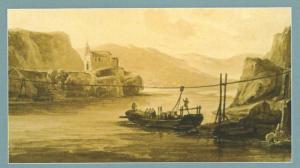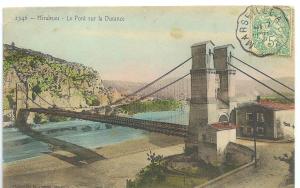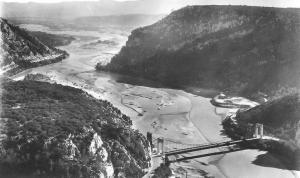The bridge(s) of Mirabeau
Four miles south of Cadarache, the Durance riverbed narrows abruptly into a gully less than 180 meters wide. This is the "Defile de Mirabeau", a natural border post between Alpine and Mediterranean Provence.
Connecting these two worlds, physically and culturally distinct, has always been a vital economic necessity, as well as a tremendous technical challenge. From the Middle Ages until the mid-19th century, people, animals and goods had to rely on a cable ferry to cross from one bank to the other.
By 1835, engineers felt confident enough to defy the river's frequent bursts of fury. But the bridge they built lasted only eight years: in 1843, a particularly violent flood swept it away.
A major technical innovation, the "suspension bridge", made a second attempt possible. The second of the Mirabeau bridges was opened in 1847 and for almost a century stretched majestically between two monumental red brick porticos. Its cables and roadway had resisted the floods and the bitter winters, but fell victim to growing motor traffic. In 1934, with dark clouds looming over Europe, it was decided to build a new bridge, wide enough to accommodate heavy trucks and military convoys.
Ten years later, on 17 August, 1944 two days after Allied forces had landed in Provence, Americans bombed the bridge in order to cut the retreat of the German army. Soon after, Resistance fighters finished the job with dynamite.
Severely damaged, the third of the Mirabeau bridges was rebuilt just after the war. It stood for 40 years, but in January of 1985, its steel cables weakened by age and cold, it was declared a "public danger", closed, dismantled, and replaced in 1989 by the present structure.
Of the 1847 bridge, the pseudo-medieval porticos have been preserved. And the four steles which decorated its 1934 successor now stand on the roundabout at the southern entrance of the present bridge. They symbolize the four "départements" which meet at Mirabeau: Vaucluse, Bouches-du-Rhone, Var and Basses-Alpes, whose name was changed into a supposedly more elegant "Alpes-de-Haute-Provence" in 1970.




